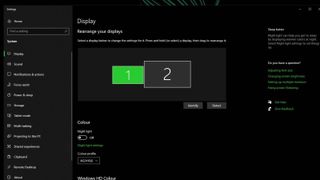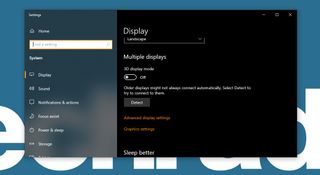How to use your laptop as a monitor
Boost your productivity or output video from another device by learning to use your laptop as a monitor

If you're like the millions of people around the world who want to be able to use your laptop as a monitor, we don't blame you - there are some serious perks to having access to a second screen and in this guide, we'll show you exactly how to do it.
Whether you have one of the best Windows laptops or you've recently taken advantage of one of the best cheap MacBook deals, using your laptop as a second screen can really boost your productivity.
For content creators, students, and those working in jobs that require constant flicking between screens and cross-referencing of documents, having a dual-screen workstation can be a real lifesaver.
As long as you own one of the best computers, you'll find it easy to extend your laptop's display across multiple monitors. This will allow you to not simply mirror your laptop's screen on the monitor but actually extend it, which means you can show different content on both screens.
How to extend your laptop display
- Connect the proper display cable
- Go into Settings and click Display Settings
- Scroll to Multiple Displays and choose your option
● System: Windows 10 or 11
● Tools: Keyboard and mouse
● Skill Level: Intermediate

1. Grab the appropriate display cable
The first step when it comes to figuring out how to use your laptop as a monitor is to grab the appropriate display cable for your laptop so you can hook it up to a monitor. Your laptop might use an HDMI cable, DisplayPort, mini-DisplayPort, or include a docking station, so find the right cable for your needs and plug it into your monitor.
2. Open Settings and display
Once that’s done, open ‘Settings > Settings > Display’. You can also right-click on your desktop and click Display Settings or use the shortcut ‘Windows key + P’ to switch between display modes quickly.
If your laptop has connected to your monitor successfully, you should see two or more numbered screens under the ‘Select and rearrange displays” section. If not, click Detect to force Windows to search for another display.
Get daily insight, inspiration and deals in your inbox
Get the hottest deals available in your inbox plus news, reviews, opinion, analysis and more from the TechRadar team.

3. Identify and extend your displays
If you’re unsure which screen is which, click Identify and a number will pop up to signify each display. You can also rearrange your displays to suit your preference, just make sure you click Apply once you’re done.
Scroll down to Multiple displays and click the dropdown. From here, you can choose from a variety of options, but the ones that we’re focusing on is Extend these displays. Select it to expand your display across multiple screens, then tick which screen you’d like to make as your main display.
4. Extend your laptop display on macOS
To connect another display to your MacBook, check the ports on your device first to determine whether you’ll need an adaptor. Once you’ve picked the right cable for the job, plug it into your monitor and move on to the next step.
Head to the Apple menu then click ‘System Preferences > Displays’ and click the Arrangement tab. Make sure that the box for Mirror Displays is not selected, and then arrange your displays by dragging them to your desired position. To set a different display as the primary display, simply drag the menu bar to the screen you’d like to use.
Final thoughts: How to use your laptop as a monitor

For this scenario, we’re going to assume that you want to use your laptop as a monitor to display your Windows 10 desktop.
Go to 'Settings > System > Projecting to this PC.' Change the first drop-down menu to 'Available everywhere on secure networks' and configure the other settings to your liking. Once that’s done head back to your desktop PC and click on the Action Center icon in the bottom right-hand corner of the taskbar.
Click on Connect and when the laptop appears that you’d like to use, select it. You will then need to accept the connection request on the laptop, and type in a pin if you choose that option.
Once that’s done, right-click on your desktop and select Desktop Settings. In the display menu, make sure you select 'Extend desktop to this display.' You can then rearrange your desktop and laptop display however you like.
Adam was formerly TRG's Hardware Editor. A law graduate with an exceptional track record in content creation and online engagement, Adam has penned scintillating copy for various technology sites and also established his very own award-nominated video games website. He’s previously worked at Nintendo of Europe as a Content Marketing Editor and once played Halo 5: Guardians for over 51 hours for charity. He is now an editor at The Shortcut.
- Allisa JamesComputing Staff Writer

